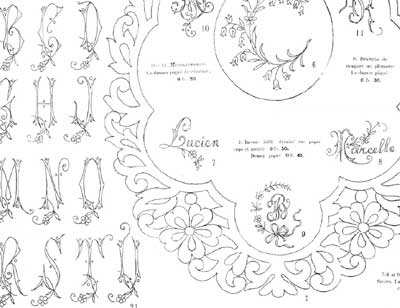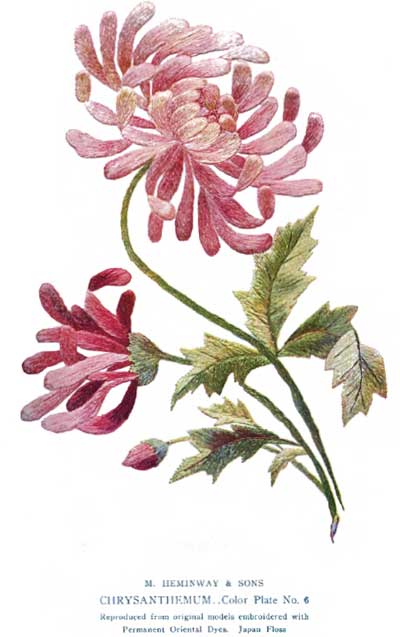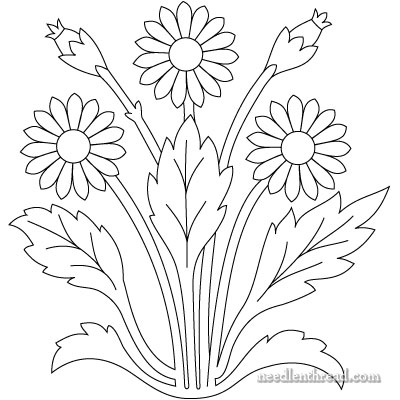After last week’s free hand embroidery pattern and the online resource for the old book it came from, I received a slew of email with several questions pertaining to that article. They were mostly pertinent enough to combine into an article on Old Embroidery Books Online, which, as today’s title suggests, is exactly what I’m doing.
If you’re not into old books, I won’t hold it against you! But I am a Strangely Passionate Old Book Fiend (“old” modifying “book” in that phrase, please). Ok, come to think of it, I’m a Strangely Passionate Book Fiend, whether old or new.
But, like I said, if you’re not into books, feel free to pass by me today, because that’s what I’m going to talk about. We can resume our relationship tomorrow, right where we left off!

Now, by old embroidery books, I mean books published anywhere from about the 1970′s, backwards – pretty much anything “before my time.” I think they attract me because they are before my time. But I seem to lean towards “the older, the better.” This isn’t exactly the case in every book instance, though, because there are some old embroidery books that I can easily give a miss, and there are some newer embroidery books that I’d turn summersaults for.

I collect old embroidery books and old embroidery pamphlets and periodicals. But I only collect them occasionally. If I buy one online, it’s because I already know what it is, and I’m looking for it specifically. When I come across one in a used book shop, estate sale, antique shop, or what-have-you, and it is a book that I would really be interested in, and the price is right, then I buy it. But I don’t just buy up any old books – I try to be discerning in the books I collect.
(Admittedly, if the old family manse here were a bit larger and had a room devoted to books only, I might be less discerning and this could develop into a serious problem…)

Discovering Old Embroidery Books
Some questions that came up: How does an old book come to my attention, and how do I know to look for it, and where do I look for it?
First, there’s this matter of reading. I actually do read the books in my needlework library, and in them – especially in anything that’s historically based – there are usually references to other books or authors. These references often intrigue me, and they lead me down various paths of exploration.
I also tend to look for books by specific authors or by people notable in any given era of embroidery. Mrs. Archibald Christie comes to mind. She wrote many excellent books on embroidery in the early 1900′s. (Samplers and Stitches is one of my favorites.) Once I had made Mrs. Christie’s acquaintance, it was easy to look for her hither and yon, and I generally keep an eye out for her at the various book haunts. I’ve collected several of her books for my own shelf, and I’ve also come across many of her works free, online.
I’ve also visited the rare books rooms at libraries to view certain of her books and other authors’ books. For example, the Topeka Public Library has a rare copy of Christie’s English Medieval Embroidery, which I’ve perused a few times. I don’t own my own copy of it, but I’d like to. The $2,000+ price tag is (needless to say) quite prohibitive!
Besides exploring references and looking for specific authors, I look for books by era. For example, the Arts & Crafts Movement intrigues me, so I tend to seek out information or read a lot about that era. My interests also tend to cross other fields of study, and because I have an interest, for example, in the Oxford Movement, in World War I poetry, in Renaissance music, in medieval illumination, and whatnot, I tend to find the art and needlework of the same eras more intriguing, too. I explore those interests and come across the names of the “movers and shakers” in the various fields of art, and this all leads to the discovery of old needlework books.

Old needlework periodicals are a little bit different. I know they exist, but my favorite ones are from France, from the mid 1800′s through the mid 1900′s. Sometimes, it’s hard to get my fingers on them. I generally search for those by the name of the publication, like La Brodeuse or La Broderie Blanche or Journal des Demoiselles or Sajou.
In English, the Carmela Testa Variety publications from the early 1900′s and the various journals like the Needlecraft Practical Journal and Weldon’s, are all favorites.
I keep up an ongoing search for these types of publications through used book sources and through eBay.

Where to Find Old Embroidery Books Online for Free
The other overwhelming question was concerning recommendations for finding free online embroidery books.
There are four online sources for free, good-quality old texts that I frequent. They are:
Internet Archive
Online Digital Archives of Documents on Weaving and Related Topics
Project Gutenberg
Antique Pattern Library
Internet Archive and Project Gutenberg both have excellent search features. If you type “embroidery” into their search field, you’ll come up with some real treasures! It sometimes take a lot of browsing to find books that particularly interest you, and you can narrow your search by adding other words, like “embroidery design” or “embroidery Christie” or “Jacobean embroidery” and so forth.
The Digital Archives on Weaving, etc. and Antique Pattern Library don’t have the same type of search feature, but if you go to the “books” page on Digital Archives or the “catalog” page on Antique Pattern Library, you can use your keyboard commands to search the listings. Just click control+F on a PC or command+F on a Mac, and a little search box will show up at the top of your browser. There, you can type in keywords, like “embroidery” and search the listings that way.
For Sajou and similar embroidery pamphlets, the best online source is Patternmaker, a blog devoted to making these old publications available. There, you’ll find many (if not all) of the old Sajou alphabet pamphlets, as well as many Russian and German pamphlets. It’s an excellent collection and well worth a browse.

Concerning Old Books and Embroidery Designs
And finally, the other questions I received concerning old books had to do with designs in particular.
Why do I bother doing a line drawing of a design that’s available in a free online book?
Fair question – because it’s easier for you (and me) to print it and use it; because my copy is cleaner and will take a lot less printer ink; and because my copy can be easily enlarged or reduced without losing resolution.
How do you make those line drawings and can you provide a tutorial for making them?
I use Adobe Illustrator or Inkscape to create vector drawings. You can look up either of these online (Inkscape if free shareware) and there are many, many tutorials online for how they work. You can also take classes to learn these things. It would be very difficult for me to offer tutorials for using them, because it would open up too many questions, especially from those not already familiar with graphics and design, that I don’t have time to answer and that are not the focus of Needle ‘n Thread.
Aren’t you violating copyright by putting that design on your website?
No. It’s in the public domain.
Someone else has already put it online in their own digital file, so isn’t that a violation of their copyright rights?
No. The design is in the public domain.
Why do you have a copyright on the design if it is from an old book?
The copyright is on my digital version, not on the design itself. It simply means you can’t take my digital version and sell it or publish it on another website, etc., without my permission.
Any Questions?
There you have it. All Old Embroidery Book Related Questions answered for this week! If you have any further questions, don’t hesitate to ask! You can leave a comment below, or you can drop me a line. I’m more likely to answer your question right away if you leave it below, and other people can benefit from your questions, too, when they are left on the website.
Enjoy your day!
